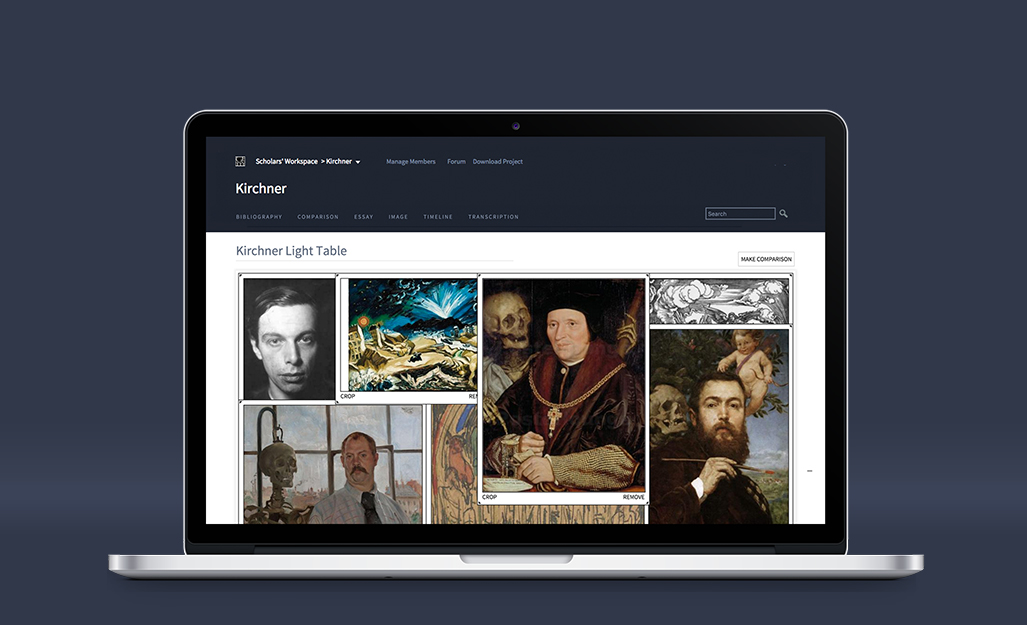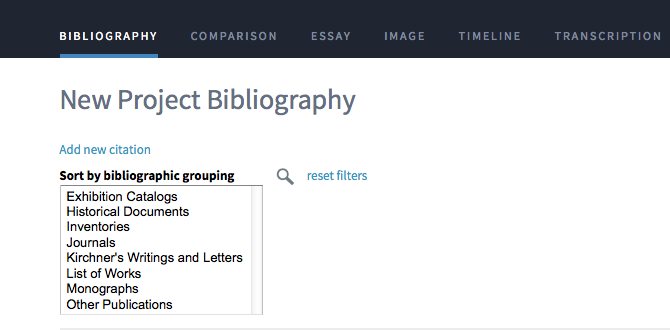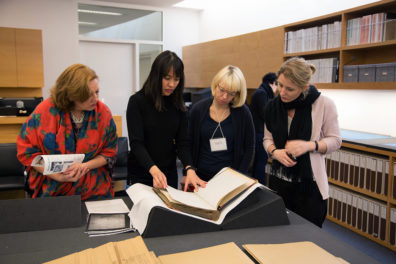
The light table tool within Getty Scholars’ Workspace. (Artwork second from left: Apocalyptic Landscape, 1912, Ludwig Meidner. © Ludwig Meidner-Archiv, Jüdisches Museum der Stadt Frankfurt am Main)
We’re thrilled to announce that the Getty Research Institute (GRI) has released Getty Scholars’ Workspace™, a free, open-source online collaborative research environment.
As I’ve emphasized before, the Getty is committed to making our resources freely available to all. We do so by providing images through our Open Content Program, making our scholarship available with online scholarly catalogs, digitizing our archives and library collections; connecting our extensive databases and library holdings through the Getty Research Portal; making our vast research datasets available as Linked Open Data; and now our new open-source software will make it possible for art historians and other humanities scholars to conduct research collaboratively online—sharing resources and ideas to advance the field.
We believe that open access and collaboration are the cornerstones of the future of art-historical research and that the promise of digital art history is increasingly found in the kind of cross-cultural and interdisciplinary exchange that Getty Scholars’ Workspace will no doubt facilitate. I look forward to seeing what my colleagues in the humanities do with this exciting new tool.
About Getty Scholars’ Workspace
Getty Scholars’ Workspace is an online environment designed to support collaborative art-historical and humanities research, where research teams can examine digital surrogates, build bibliographies, translate and annotate texts, share and annotate images, and exchange ideas. With Getty Scholars’ Workspace, research and communication are consolidated into a single online location accessible from anywhere.
Getty Scholars’ Workspace features these collaborative research tools:
- Bibliography builder: to collaboratively manage citations online
- Comparison tool: to upload images and create comparisons on a digital “light table”
- Essay tool: to write, edit, and annotate texts
- Forum: to record and store project-related correspondence in a centralized location
- Image tool: to upload, crop, and annotate images, and create image comparisons
- Manuscript presentation tool: to upload a manuscript or other archival document and record transcriptions and translations
- Timeline tool: to create an illustrated list of relevant dates in chronological order
Scholars’ Workspace was built in version 7.21 of Drupal, an open-source content management system. We expect the open-source community to generate significant support and new creative uses and features for the system, and we look forward to an open exchange of ideas based around this project.

The bibliography tool within Getty Scholars’ Workspace
How to Use It
Getty Scholars’ Workspace can be used with digital content from any museum or archive. It does, however, require technological expertise and will work best for users who have technical support in their own institutions. An installation guide and user manual are downloadable from the Scholars’ Workspace webpage.
For more information on the Scholars’ Workspace, and links to our user guide, installation instructions, and codebase, see this page.
What’s Next
A project conducted in the Getty Scholars’ Workspace could result in an exhibition, a seminar, a digital or print publication, a scholarly talk, or something else entirely. While it is not designed to produce these outcomes itself, Scholars’ Workspace helps research teams organize their materials, such as texts and images, and facilitate collaborative analysis and investigation. A research team composed of scholars at the Avery Architectural & Fine Arts Library, Columbia University, and the University of Bologna is currently planning a project on an unpublished 16th-century manuscript by the highly influential architect and writer Sebastiano Serlio.
Tell us how you might use Getty Scholars’ Workspace!
_______
Getty Scholars’ Workspace™ was made possible in part through generous support from the Seaver Institute.




This looks magnificent! I am going to transfer my bibliography on the subject of pigments and pigment analysis of paintings for my website http://colourlex.com to this tool and initiate colaboration with other scientists in this area of interest.
Thank you for your work.
Juraj